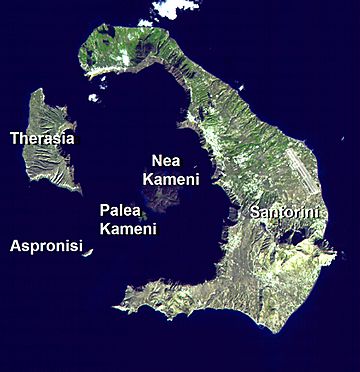Santorini caldera facts for kids
Quick facts for kids Santorini Caldera |
|
|---|---|

The Santorini island group seen from space
|
|
| Highest point | |
| Geography | |
| Location | Aegean Sea, Greece |
| Geology | |
| Mountain type | Caldera (active) |
| Last eruption | 1950 |
The Santorini caldera is a huge, mostly underwater caldera. A caldera is a large, bowl-shaped hollow that forms when the ground above a volcano's magma chamber collapses after an eruption. This caldera is located in Greece, in the southern Aegean Sea. It is about 120 kilometers (75 miles) north of the island of Crete. What you can see above the water is a group of islands that form a circle, known as the Santorini island group.
The caldera itself is about 12 kilometers (7.5 miles) long and 7 kilometers (4.3 miles) wide. It has very steep cliffs, up to 300 meters (980 feet) high, on three sides. In the middle of the caldera, there are two smaller volcanic islands called Nea Kameni ("New" Kameni) and Palea Kameni ("Old" Kameni). The main island, Santorini, covers an area of about 75.8 square kilometers (29.3 square miles).
Santorini is famous for its amazing beauty. The high cliffs are covered with white-painted villages. This, along with sunny weather and clear air, makes it a very popular place for tourists. It also attracts scientists who study volcanoes.
What is the Geology of Santorini?
The volcanic area of Santorini is the most active part of the South Aegean Volcanic Arc. This arc is a line of volcanoes formed because the African tectonic plate is slowly sliding underneath the Aegean part of the Eurasian tectonic plate. This movement happens at a speed of up to 5 centimeters (2 inches) per year towards the northeast. This process also causes earthquakes deep underground, about 150–170 kilometers (93–106 miles) deep.
You can find older, non-volcanic rocks on Santorini in several places. These include Profitis Ilias Mountain, Mesa Vouno, the Gavrillos ridge, Pirgos, Monolithos, and along the inside of the caldera wall between Cape Plaka and Athinios. The Kameni islands, which are in the center of the caldera, are made from newer lava rocks.
How Does Santorini's Volcano Work?
The Santorini caldera is made up of several overlapping shield volcanoes. A shield volcano is a wide volcano with gentle slopes, built up by many layers of fluid lava flows. This area has been shaped by at least four calderas that formed over time. The oldest southern caldera was created about 180,000 years ago. The Skaros caldera formed around 70,000 years ago, and the Cape Riva caldera about 21,000 years ago. The caldera we see today was formed about 3,600 years ago during a huge eruption known as the Minoan eruption.
The islands of Palea Kameni and Nea Kameni grew from many eruptions that first happened underwater in the middle of the caldera. Even though it is not erupting violently right now, Santorini is still considered an active volcano. Many smaller eruptions have happened over time. These eruptions have built up the dark-colored lava islands of Nea and Palea Kameni inside the caldera.
The last time Santorini had an eruption was in 1950. Today, only smoke and gases come out of the volcano. However, GPS instruments have shown that the ground around the caldera started to move and change shape again in 2011 and 2012. This shows that the volcano is still active.
The enormous Minoan eruption of Santorini happened in the 17th century BC. Some people believe this powerful event might have inspired the ancient legend of Atlantis. This eruption was given a score of 7 on the Volcanic Explosivity Index (VEI). This is the highest score for any historical eruption, showing just how powerful it was.
See also
 In Spanish: Caldera Santorini para niños
In Spanish: Caldera Santorini para niños




